Family variety
Porcupine Pufferfish are a small family consisting of just 19 individual species, around 6 of which are found in South-east Asian waters. All species have a similar body shape and are covered with numerous sharp spines. In some species these spines are fixed pointing directly outwards. In others, the spines lie flat, only pointing outwards when the fish is inflated. Alternate names include Burrfish and Balloonfish.
Size
Adult Porcupine Pufferfish vary in size from the tiny 20cm Obicular Burrfish (Cyclichthys obicularus) up to the Porcupinefish (Diodon hystrix) at 70cm.
Behaviour
Because Porcupine Pufferfish have many natural defences, they tend to be slow moving and docile. Some individuals have been know to be very curious, swimming up to divers and accompanying them through the water as they swim.
Porcupine pufferfish are usually solitary and are only seen in pairs or small groups when mating.
Distribution
Porcupine Pufferfish are found throughout sub-tropical and tropical waters. Some species can be quite common in a specific location.
Habitat
Juvenile Porcupine Pufferfish are usually pelagic, settling inshore when they reach a certain size. They feed at night, foraging around on the sand or reef bottom. In the day they are often seen resting under overhangs or in crevices as they hunt primarily at night. They are usually found near the sea bed or hovering in mid-water.
Diet
Porcupine Pufferfish feed on reef invertebrates such as sea urchins, molluscs and crustaceans. They feed at night using their hard-plated mouth to break open the shells of their prey. Their teeth never stop growing and need to be kept in trim with constant chewing on hard corals, rocks and shells.
Reproduction
Little is know about the reproduction of Porcupine Pufferfish and telling the sexes apart is very difficult. It is assumed they pair together to mate, releasing pelagic eggs.
Defences
Porcupine Pufferfish have an array of highly effective defence mechanisms. They are they able to suck in water and inflate their bodies to twice its original size. In addition, their inflated bodies are covered in short sharp spines making it very difficult for a predator to take a bite. Their strong hard jaws - capable of crunching through the hardest of shells - also work well to deter predators. Just in case predators are still interested, the flesh of Porcupine Pufferfish is also highly poisonous, containing tetradoxin, an extremely powerful poison. All in all, despite their endearing appearance, Porcupine Pufferfish are more than a match for most predators.
Threats
Porcupine pufferfish are often sold dead and dried as souvenirs in the tourist trade. They are also easily stressed and become vulnerable if they have cause to inflate their bodies too many times. If they inflate near the surface they can inflate with air instead of water, causing internal damage.
Did You Know?
Porcupine Pufferfish can recognise feeders in captivity and often behave like dogs, swimming to the top of their tanks to await food.
They are ranked as one of the "smart" fish, with a higher than average intelligence.
Intro
With their large expressive eyes & often curious nature, Porcupine Pufferfish are regular favourites with divers. They are relatively big for reef fish and have a body that is entirely covered in short spines.
When stressed or threatened they have the ability to suck in water to increase the size of their bodies, giving them their name. When fully inflated, their spines stick straight out from their rounded bodies, making them impossible for all but the biggest of mouths to swallow.
Unlike many reef fish they can be quite curious and if not sleeping on the reef will often approach divers for a closer look, maybe a result of their confidence in their amazing defences.
Popular species 1
Porcupinefish
(Diodon hystrix)
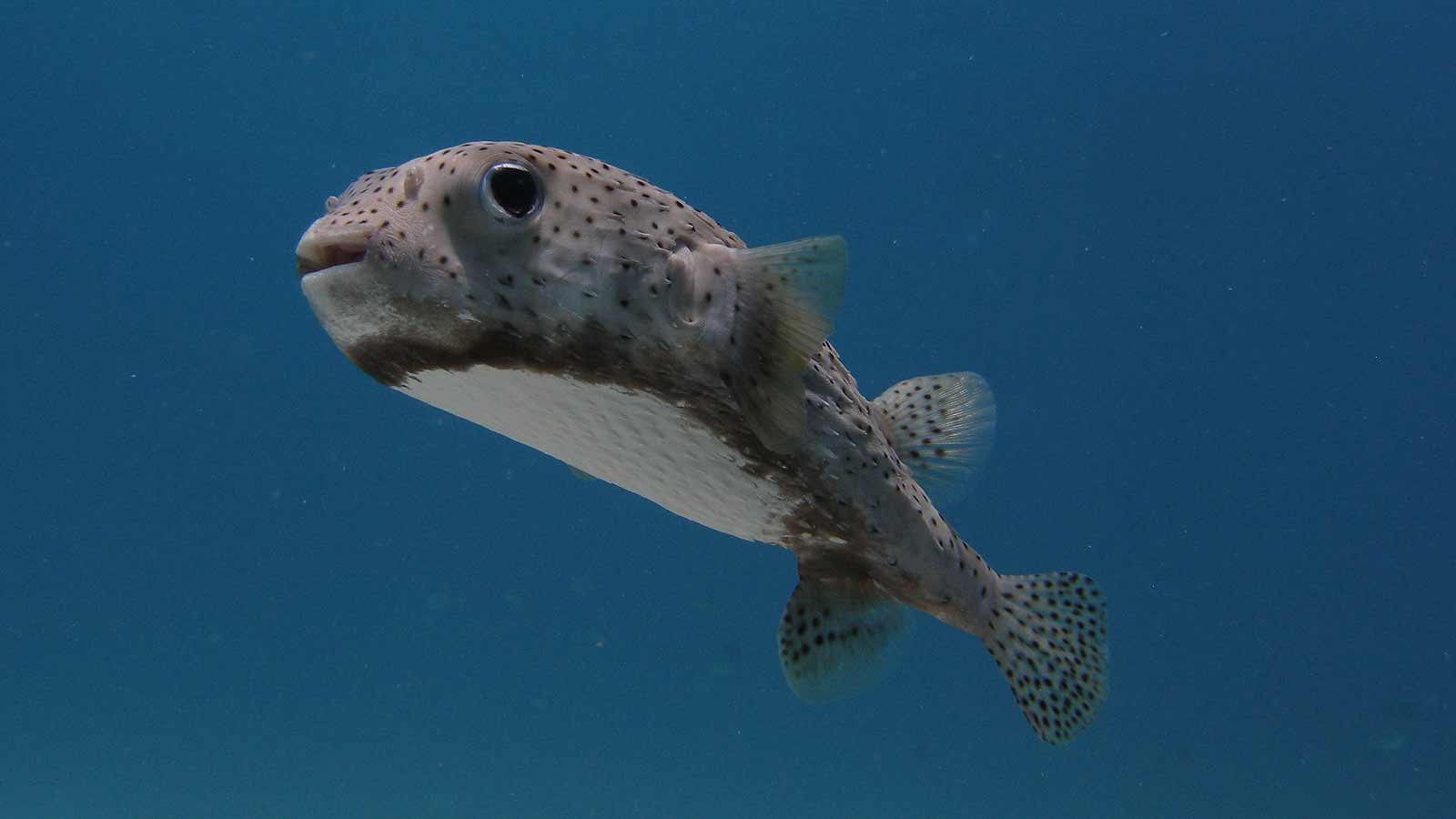
Largest family member, up to 90cm in length. Yellow or beige colour with many small black dots and a paler underside. They are found throughout the world’s tropical waters, and are extremely common in certain areas.
Juveniles are pelagic, settling on the reef when they reach around 20cm in size. Often very curious, adults search out shallow lagoons and seaward reefs and can often be found sheltering under ledges or in caves during the day.
Popular species 2
Black Blotched Porcupine Pufferfish
(Diodon liturosus)
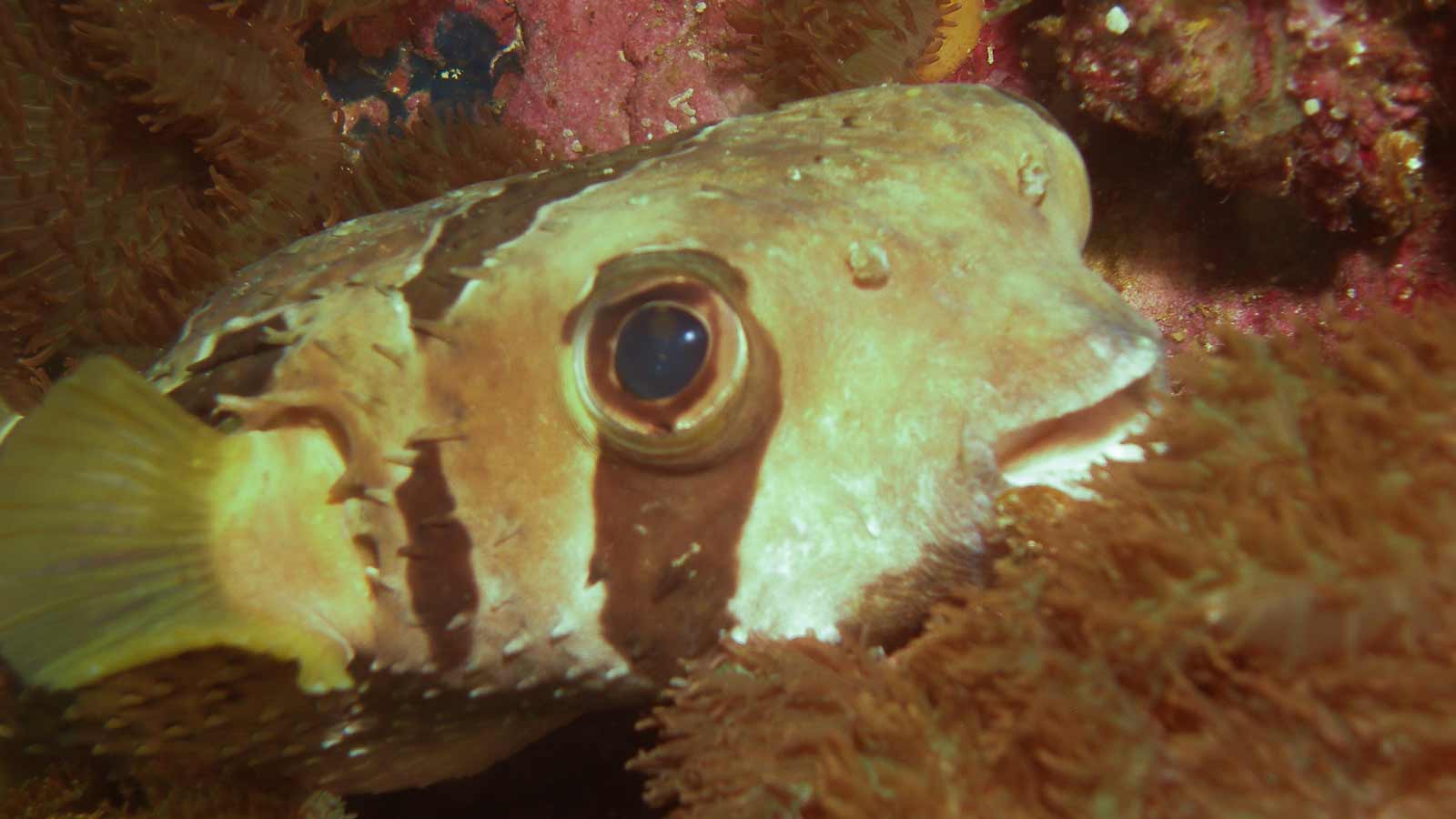
This species can reach up to 60cm in length, An uncharacteristically shy member of the family, it often wedges itself into crevices or under ledges during the day.
Inhabiting reefs from the Red Sea to Austrailia, it is easily identified by its distinctive black blotches on its creamy yellow skin.
Popular species 3
Spotbase Burrfish
(Cyclichthys spilostylus)
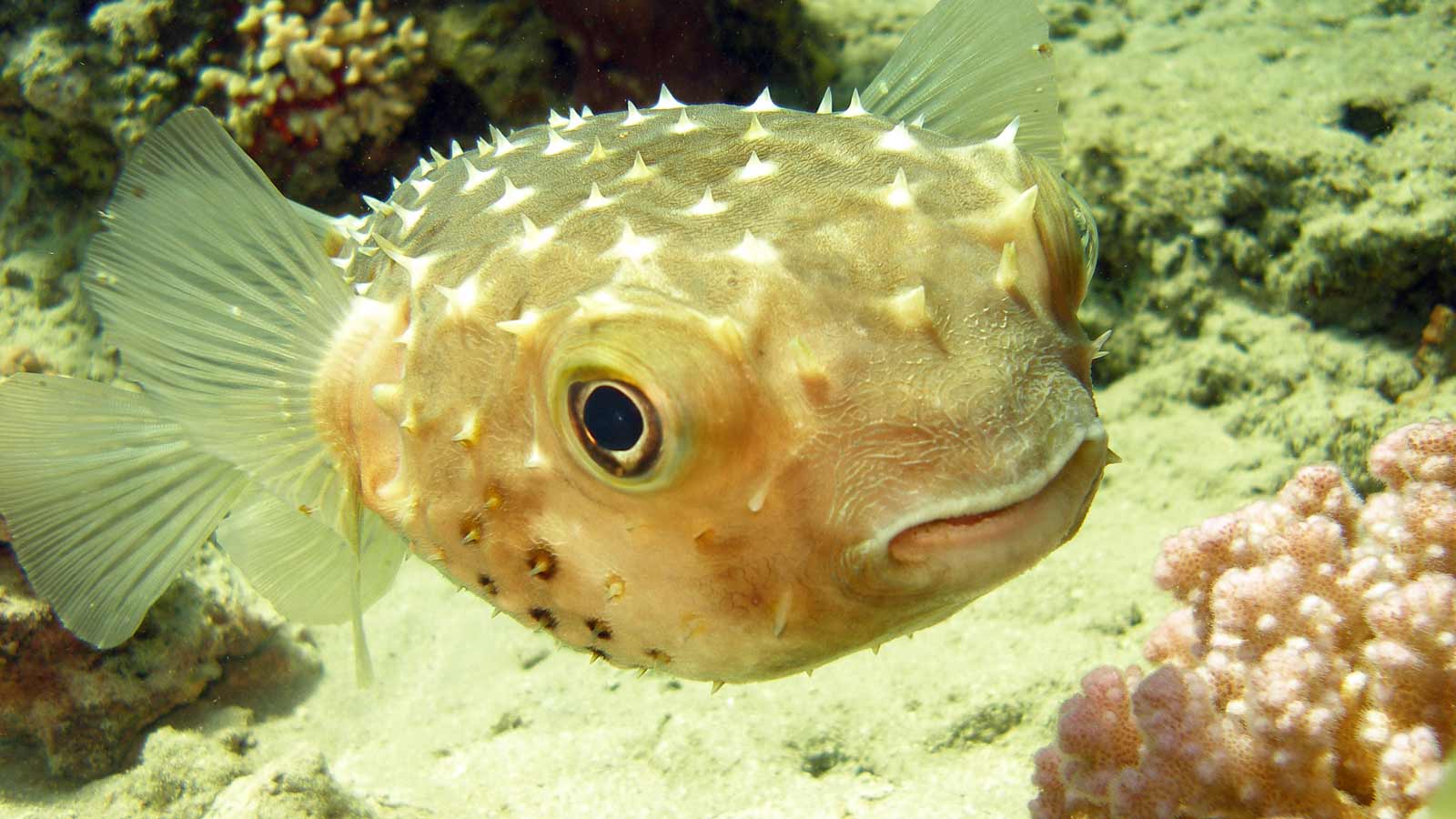
Only 35cm in length, this is one of the smaller family members. It can be spotted from the Red Sea to Austrailia & often lives in or near seagrass.
Like all family members, it tends to feed at night on molluscs and crustaceans and spends its days getting some rest.
Popular species
Porcupine pufferfish are commonly encountered on reefs throughout Asia. Here are some popular species of the family.
FACTFILE
 SPECIES: 19. 6 in Asian waters.
SPECIES: 19. 6 in Asian waters.
 SIZE RANGE: 20-70 cm
SIZE RANGE: 20-70 cm
 DISTRIBUTION:
DISTRIBUTION:
Found in tropical and sub-tropical regions.
 HABITAT:
HABITAT:
Pelagic as juveniles, settling in shore when larger. Usually found near seabed or mid-water.
 THREATS:
THREATS:
Easily stressed and become vulnerable if they inflate too often. Sometimes sold as souvenirs.
Identification tips
-
The ability to inflate their body by swallowing water (or air) and become round like a ball.
-
Large eyes as they are mainly nocturnal, often hiding in caves or beneath ledges during the day.
-
Sharp heavy spines cover their head and body which in some species lie flat, only radiating outwards when the fish is inflated.
-
Dorsal and anal fins positioned far back on the body.
-
A single plate of fused teeth in each of the upper and lower jaws, ideal for crushing the hard shelled invertebrates they eat.
-
No pelvic fins
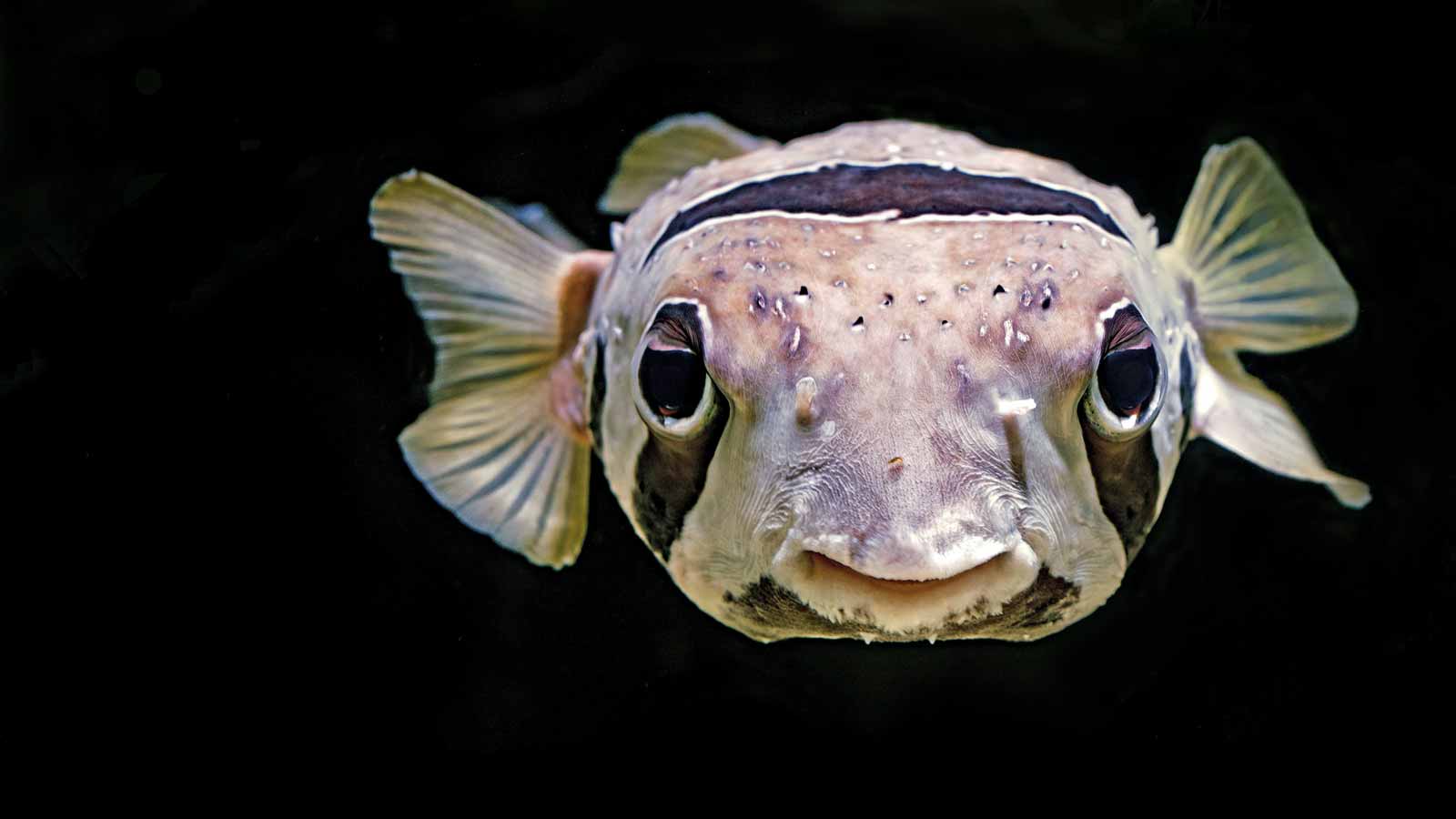
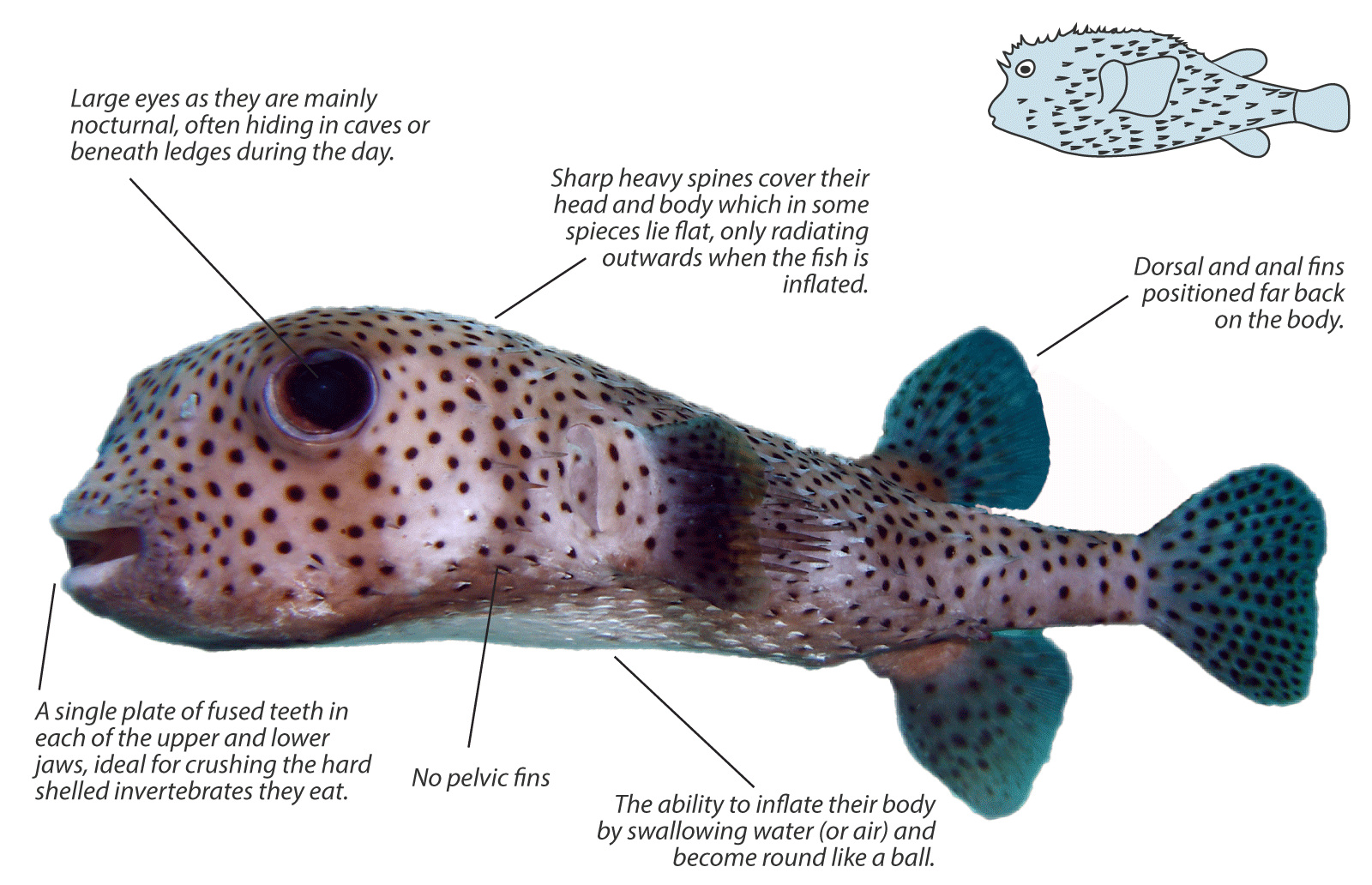



SPECIES: 19. 6 in Asian waters.
SIZE RANGE: 20-70 cm
DISTRIBUTION:
HABITAT:
THREATS: